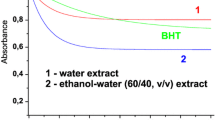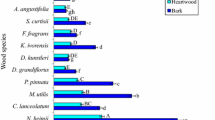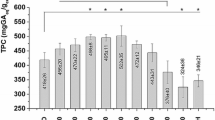Abstract
Recently, the value of wood residues has received increasing attention due to the presence of pharmacologically active compounds. In the present study, apple bark was treated with subcritical water (SWE) with the aim of bioactivity determination and chemical analysis by GC–MS applying two different sample preparation protocols and by HPLC. Extracts were screened for their total antioxidant capacity by means of total phenolic (TPC) and flavonoid contents (TFC), ferric reducing antioxidant power (FRAP) and DPPH-radical scavenging activity (DPPH-RSA). Anti-microbial and anti-proliferative activities of the apple bark subcritical water extracts were also examined. Different lignin and cellulose degradation products were identified by GC–MS, as well as naturally present compounds. Identified compounds encompassed organic and fatty acids, alcohols, sugars, phenol, benzaldehyde, cinnamic acid, cinnamaldehyde and azulene derivatives, as well as other organic compounds. Phenolic profiles of apple bark extracts defined by HPLC–PDA analysis revealed that the main contributors were gallic acid (9.4 ± 0.5 mg/g DW) and catechin (8.3 ± 0.4 mg/g DW). The diversity of the extracts composition supports the fact that this medium is able to extract compounds of different polarities, simultaneously acting as catalyst and reactant. The characterized apple bark extracts demonstrated good antioxidant (TPC = 31.47 ± 1.86 mg GAE/g; TFC = 17.40 ± 1.89 mg EE/g; FRAP = 22.45 ± 2.22 mg AAE/g; DPPH-RSA = 22.57 ± 2.24 mg Trolox E/g DW), antimicrobial (MIC = 19.53–156.25 μg/mL) and anti-proliferative activity (IC50 = 19.88–47.44 μg/mL). The findings of this study showed that SWE can be used as an environmentally friendly and safe technique for the valorization of apple tree wood residues, applicable in food and pharmaceutical industries.
Graphic Abstract



Similar content being viewed by others
References
Boyer, J., Hai Liu, R.: Apple phytochemicals and their health benefits. Nutr. J. 3, 5 (2004). https://doi.org/10.1186/1475-2891-3-5
Gosch, C., Halbwirth, H., Stich, K.: Phloridzin: biosynthesis, distribution and physiological relevance in plants. Phytochemistry 71, 838–843 (2010). https://doi.org/10.1016/j.phytochem.2010.03.003
Švarc-Gajić, J.: Biological Activity of Natural Products. Nova Science Publishers, New York (2013)
Hong-Zhen, S., Hai-Tao, L., Su-Hua, B., Bao-Hua, L., Jun, Z., Hong-Yi, D.: Determination method of 12 phenolic compounds in apple bark by HPLC. Int. J. Fruit. Sci. 5, 929–935 (2012)
Leppänen, K., Spetz, P., Pranovich, A., Hartonen, K., Kitunen, V., Ilvesniemi, H.: Pressurized hot water extraction of Norway spruce hemicelluloses using a flow-through system. Wood. Sci. Technol. 45(2), 223–236 (2011). https://doi.org/10.1007/s00226-010-0320-z
Švarc-Gajić, J.: Sampling and Sample Preparation in Analytical Chemistry. Nova Science Publisher, New York (2012)
Simsek, K.N.: Organic reactions in subcritical and supercritical water. Tetrahedron 68, 949–958 (2012)
Khuwijitjaru, P., Sayputikasikorn, N., Samuhasaneetoo, S., Penroj, P., Siriwongwilaichat, P., Adachi, S.J.: Subcritical water extraction of flavoring and phenolic compounds from cinnamon bark (Cinnamomum zeylanicum). J. Oleo. Sci. 61, 349–355 (2012). https://doi.org/10.5650/jos.61.349
Co, M., Koskela, P., Eklund-Åkergren, P., Srinivas, K., King, J.W., Sjöberg, P.J.R., Turner, C.: Pressurized liquid extraction of betulin and antioxidants from birch bark. Green. Chem. 11, 668–674 (2009). https://doi.org/10.1039/B819965E
Co, M., Fagerlund, A., Sunnerheim, K., Engman, L., Sjoberg, P.J.R., Turner, C.: Extraction of antioxidants from spruce (Picea abies) bark using eco-friendly solvents. Phytochem. Anal. 23, 1–11 (2012). https://doi.org/10.1002/pca.1316
Dorosh, O., Moreira, M.M., Pinto, D., Peixoto, F.A., Freire, C., Costa, P., Rodrigues, F., Delerue-Matos, C.: Evaluation of the extraction temperature influence on polyphenolic profiles of vine-canes (Vitis vinifera) subcritical water extracts. Foods 9(7), 872 (2020)
Moreira, M.M., Barroso, M.F., Porto, J.V., Ramalhosa, M.J., Švarc-Gajić, J., Estevinho, L., Morais, S., Delerue-Matos, C.: Potential of Portuguese vine shoot wastes as natural resources of bioactive compounds. Sci. Total Environ. 634, 831–842 (2018)
Moreira, M.M., Barroso, M.F., Boeykens, A., Withouck, H., Morais, S., Delerue-Matos, C.: Valorization of apple tree wood residues by polyphenols extraction: comparison between conventional and microwave-assisted extraction. Ind. Crops Prod. 104, 210–220 (2017)
Alsaud, N., Farid, M.: Insight into the influence of grinding on the extraction efficiency of selected bioactive compounds from various plant leaves. Appl. Sci. 10(18), 6362 (2020)
Švarc-Gajić, J., Cvetanović, A., Segura-Carretero, A., Borrás Linares, I., Mašković, P.: Characterisation of ginger extracts obtained by subcritical water. J. Supercrit. Fluid. 123, 92–100 (2017). https://doi.org/10.1016/j.supflu.2016.12.019
Carvalho, A.P., Mendes, M., Moreira, M.M., Cruz, D., Magalhães, J.M.C.S., Barroso, M.F., Ramalhosa, M.J., Duarte, A., Guido, L., Gomes, A.M., Delerue-Matos, C.: Microwave-assisted extraction in goji berries: effect on composition and bioactivity, evaluated through conventional and nonconventional methodologies. Int. J. Food Sci. Nutr. 51, 1401–1408 (2016). https://doi.org/10.1111/ijfs.13105
Paz, M., Gúllon, P., Barroso, M.F., Carvalho, A.P., Domingues, V.F., Gomes, A.M., Becker, H., Longhinotti, E., Delerue-Matos, C.: Brazilian fruit pulps as functional foods and additives: evaluation of bioactive compounds. Food Chem. 172, 462–468 (2015). https://doi.org/10.1016/j.foodchem.2014.09.102
Satyajit, D., Sarker, L.N., Kumarasamy, Y.: Microtitre plate based antibacterial assay incorporating resazurin as indicator of cell growth, and its application in the in vitro antibacterial screening of phytochemicals. Methods 42, 321–324 (2007). https://doi.org/10.1016/j.ymeth.2007.01.006
Mosmann, T.: Rapid colorimetric assay for cellular growth and survival: application to proliferation and cytotoxicity assays. J. Immunol. Methods 65, 55–63 (1983)
Nastić, N., Švarc-Gajić, J., Delerue-Matos, C., Barroso, M.F., Soares, C., Moreira, M.M., Morais, S., Mašković, P., Srček, V.G., Slivac, I., Radošević, K.: Subcritical water extraction as an environmentally-friendly technique to recover bioactive compounds from traditional Serbian medicinal plants. Ind. Crops Prod. 111, 579–589 (2018). https://doi.org/10.1016/j.indcrop.2017.11.015
Roberts, G., Spadora, N.D.: Analysis of apple flavours: the use of volatile organicto address cultivar differences and the correlation between consumer appreciation and aroma profiling. J. Food Qual. 2020, 7 (2020)
Saravanan, P., Chandramohan, G., Mariajancyrani, J., Shanmugasundaram, P.: GC-MS analysis of phytochemical constituents in ethanolic bark extract of Ficus religiosa Linn. Int. J. Pharm. Sci 6(1), 457–460 (2014)
Ibáñez, A.B., Bauer, S.: Analytical method for the determination of organic acids in dilute acid pretreated biomass hydrolysate by liquid chromatography-time-of-flight mass spectrometry. Biotechnol. Biofuels 7, 145 (2014). https://doi.org/10.1186/s13068-014-0145-3
Dodd, M.C., Stillman, W.B., Roys, M., Crosby, C.: The in vitro bacteriostatic action of some simple furan derivatives. J. Pharmacol. Exp. Ther. 82, 111–118 (1944)
Brown, J.S., Glaser, R., Liotta, C.L., Eckert, C.A.: Acylation of activated aromatics without added acid catalyst. Chem. Comm. 14, 1295–1296 (2000). https://doi.org/10.1039/B001544J
Hazardous Substances Data Bank (HSDB): Acetophenone. https://pubchem.ncbi.nlm.nih.gov/source/hsdb/969 (2020). Accessed 29 July 2020
Gaur, R.K., Sharma, P.: Approaches to Plant Stress and Their Management. Springer, India (2014)
Aeschbacher, H., Wolleb, U., Löliger, J., Spadone, J.C., Liardon, R.: Contribution of coffee aroma constituents to the mutagenicity of coffee. Food Chem. Toxicol. 27, 227–232 (1989). https://doi.org/10.1016/0278-6915(89)90160-9
Chi Tang, H., Ken, N., Zhang, J.: Isolation and identification of volatile flavor compounds in fried bacon. J. Agric. Food Chem. 31, 336–342 (1983). https://doi.org/10.1021/jf00116a038
Ron, G., Richard, M., Guadagni, D., Louisa, C.: Characterization of volatile pyrazine and pyridine components of potato chips. J. Agric. Food Chem. 19, 969–971 (1971). https://doi.org/10.1021/jf60177a020
Walia, M., Kumar, S., Agnihotri, V.K.: UPLC-PDA quantification of chemical constituents of two different varieties (golden and royal) of apple leaves and their antioxidant activity. J. Sci. Food Agric. 96, 1440–1450 (2016). https://doi.org/10.1002/jsfa.7239
Xu, Y., Fan, M., Ran, J., Zhang, T., Sun, H., Dong, M., Zhang, Z., Zheng, H.: Variation in phenolic compounds and antioxidant activity in apple seeds of seven cultivars. Saudi. J. Biol. Sci. 23, 379–388 (2016). https://doi.org/10.1016/j.sjbs.2015.04.002
Mayr, U., Treutter, D., Santos-Buelga, C., Bauer, H., Feucht, W.: Developmental changes in the phenol concentrations of ‘Golden Delicious’ apple fruits and leaves. Phytochemistry 38, 1151–1155 (1995). https://doi.org/10.1016/0031-9422(94)00760-q
Burda, S., Oleszek, W., Lee, C.Y.: Phenolic compounds and their changes in apples during maturation and cold storage. J. Agric. Food Chem. 38, 945–948 (1990). https://doi.org/10.1021/jf00094a006
Plaza, M., Abrahamsson, V., Turner, C.: Extraction and neoformation of antioxidant compounds by pressurized hot water extraction from apple byproducts. J. Agric. Food Chem. 61, 5500–5510 (2013). https://doi.org/10.1021/jf400584f
Lee, K.W., Kim, Y.J., Kim, D.O., Lee, H.J., Lee, C.Y.: Major phenolics in apple and their contribution to the total antioxidant capacity. J. Agric. Food Chem. 51, 6516–6520 (2003). https://doi.org/10.1021/jf034475w
Chabi Sika, K., Sina, H., Adoukonou-Sagbadja, H., Ahoton, L.E., Roko, G.O., Saidou, A., Adeoti, K., Ahanchede, A., Baba-Moussa, L.: Antimicrobial activity of Anacardium occidentale L. leaves and barks extracts on pathogenic bacteria. Afr. J. Microbiol. Res. 8, 2458–2467 (2014). https://doi.org/10.5897/AJMR2014.6859
Stamenić, M., Vulić, J., Đilas, S., Misić, D., Tadić, V., Petrović, S., Zizović, I.: Free-radical scavenging activity and antibacterial impact of Greek oregano isolates obtained by SFE. Food Chem. 15, 307–315 (2014). https://doi.org/10.1016/j.foodchem.2014.05.091
Cvetanović, A., Švarc-Gajić, J., Mašković, P., Savić, S., Nikolić, L.J.: Antioxidant and biological activity of chamomile extracts obtained by different techniques: perspective of using superheated water for isolation of biologically active compounds. Ind. Crops Prod. 65, 582–591 (2015). https://doi.org/10.1016/j.indcrop.2014.09.044
Mašković, P., Diamanto, L., Vujic, J., Cvetanović, A., Radojković, M., Gadžurić, S., Zengin, G.: Onosma aucheriana: a source of biologically active molecules for novel food ingredients and pharmaceuticals. J. Funct. Foods 19, 479–486 (2015). https://doi.org/10.1016/j.jff.2015.09.054
Yadala, P., Viswanathswamy, A.: In vitro antioxidant and cytotoxic activity of rutin and piperine and their synergistic effect. Int. J. Pharm. Pharm. Sci. 8, 78–82 (2016)
Suffness, M., Pezzuto, J.M.: Methods in Plant Biochemistry: Assays for Bioactivity, pp. 71–133. Academic Press, Cambridge (1990)
Sak, K.: Cytotoxicity of dietary flavonoids on different human cancer types. Pharmacogn. Rev. 8, 122–146 (2014). https://doi.org/10.4103/0973-7847.134247
Acknowledgements
The authors are grateful to the Serbian Ministry of Education, Science and Technological Development (451-03-68/2020-14/200134), Provincial Secretariat for High Education and Scientific Research AP Vojvodina, Serbia (Project No. 142-451-3240/2020-03), Provincial Secretariat for Science and Technological Development and Portuguese Ministry of Science (FCT/Servia 2015/2016 proc. 441.00 SERVIA). Financial support from the Ministerio de Economía y Competitividad (Spanish Government) through the Grant CTQ2016-77155-R is also gratefully acknowledged. R. Suárez thanks to the Conselleria d’Educació, Cultura i Universitats from the Government of the Balearic Islands for a PhD stipend co-financed by Fondo Social Europeo (FPI/1444/2012). S. Clavijo acknowledges to Torres Quevedo Program of the Ministerio de Economía y Competitividad (MINECO) co-financed by European Funds, for the financial support through the PTQ 15-08038. This work was also supported by UIDB/50006/2020 and UIDP/50006/2020 by the Fundação para a Ciência e a Tecnologia (FCT)/Ministério da Ciência, Tecnologia e Ensino Superior (MCTES) through national funds. Manuela M. Moreira (project CEECIND/02702/2017) is grateful for the financial support financed by national funds through FCT and to REQUIMTE/LAQV. Manuela M. Moreira (SFRH/BPD/97049/2013) and M. F. Barroso (SFRH/BPD/78845/2011) are grateful for the postdoctoral fellowships financed by POPH-QREN—Tipologia 4.1—Formação Avançada, subsidized by Fundo Social Europeu and Ministério da Ciência, Tecnologia e Ensino Superior. The financial support from Fundação para a Ciência e Tecnologia/ Ministério da Ciência, Tecnologia e Ensino Superior (FCT/MEC) through national funds and co-financed by European Regional Development Fund (FEDER), under the Partnership Agreement PT2020 through the project UID/ QUI/50006/2013—POCI/01/0145/FERDER/007265 is also acknowledged. Annick Boeykens wishes to acknowledge Odisee for funding by means of a PWO grant (Flemish Government; Belgium).
Author information
Authors and Affiliations
Corresponding author
Additional information
Publisher's Note
Springer Nature remains neutral with regard to jurisdictional claims in published maps and institutional affiliations.
Rights and permissions
About this article
Cite this article
Švarc-Gajić, J., Cerdà, V., Delerue-Matos, C. et al. Chemical Characterization and In Vitro Bioactivity of Apple Bark Extracts Obtained by Subcritical Water. Waste Biomass Valor 12, 6781–6794 (2021). https://doi.org/10.1007/s12649-021-01477-z
Received:
Accepted:
Published:
Issue Date:
DOI: https://doi.org/10.1007/s12649-021-01477-z




